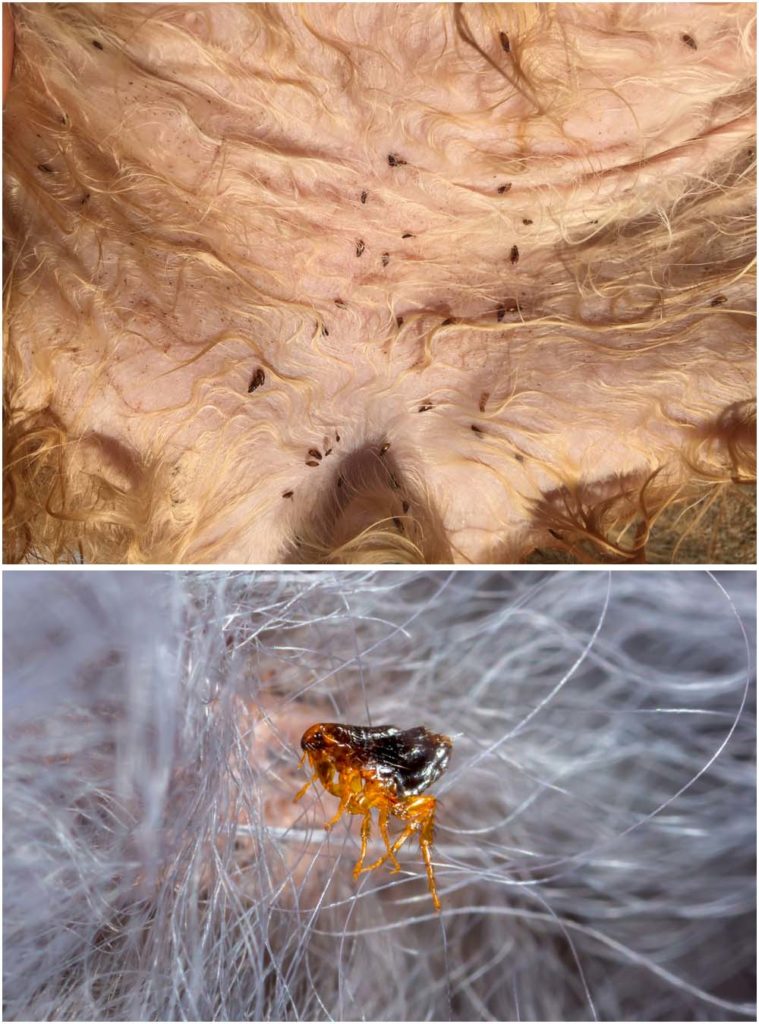Table of Contents
Fleas are small, dark brown parasites that live outside and are more prevalent in warm weather. Fleas thrive in temperatures between 65 and 80 degrees. They also prefer humid weather, between 75 and 85 percent.
In areas of the country where the climate is humid and warm year-round, fleas can survive throughout the year. A flea’s bite causes a dog to itch and scratch. Some dogs and people can even be allergic to fleas.
Fleas reproduce quickly by laying eggs and staying on the surface of their host. While fleas do not have wings, they are able to jump and move quickly, which is how they are able to move from host to host.
This is what fleas on a dog look like up close:
Why are Fleas Bad?
Fleas can cause numerous problems for you and your dog. Their bite causes painful itching and scratching. If the itching and scratching are too rough, your dog can suffer from hair loss or develop infections.
Some dogs have allergic reactions to a flea’s saliva, which could cause them excessive pain, respiratory illness, blood loss, and anemia.
Fleas can be difficult to get rid of because they are small, fast, and reproduce quickly. It takes just one flea to lay eggs on a host for there to be a growing infestation. An adult flea can lay up to 30 flea eggs per day.
Some of flea's eggs will fall off of the dog and land in the grass, bedding, carpeting, and other places where the dog stays, including your home. It takes as few as two weeks for a flea to go from egg to adult and begin home infestation.
How Can My Dog Get Fleas?
As previously mentioned, fleas love warm weather and live outside. If your dog likes to play outdoors, even if it is just for a few minutes, they can be exposed to fleas.
For a dog to “get fleas,” the flea will jump on the dog and move around the dog’s fur-line, on top of the skin. Once a female flea is on your dog, it may begin to lay eggs and is capable of laying eggs every day.
Fleas may also be transferred from dog to dog, dog to human, or human to dog. They also live on other animal hosts, too. If your dog is around other animals that live outside, they may be exposed to fleas.
What to Do If Your Dog Has Fleas
If you think you've seen fleas on your dog, you should treat them for fleas as soon as possible. If you are unsure that your dog has fleas because you do not see the insect but they are scratching and licking excessively, you should look for “flea dirt.”
Flea dirt is the term used for the excrement that a flea leaves behind on a dog. It is made up of flea feces and dried blood. If you were to remove the dirt like spots from your dog and put them on a wet paper towel, the specks would spread and lighten in color.
How Can I Treat My Dog for Fleas?
There are several different treatments for dogs with fleas. Some treatments are over the counter medications, and others are available by prescription only. Both over the counter medications and prescription medications are available in oral and topical treatments.
Oral treatments are typically prescribed by a veterinarian; however, there are some over the counter oral treatments available. This type of treatment is beneficial because it is one of the fastest ways to get rid of the fleas on a dog.
Some over the counter flea medications take just 30 minutes to start killing adult fleas and will kill up to 90 percent of the fleas within several hours.
Over the counter flea treatments include:
- Flea shampoo
- Flea spray
- Flea powder
- Flea pills
- Spot treatments
- Flea collars
- Prescription oral medications
- Home remedies
Many veterinarians will suggest that a dog owner try an over the counter treatment prior to administering a prescription. This is for two main reasons: one, because over the counter medications have excellent success rates; two, because animals may come into contact with fleas even after they have taken the prescription medication which means they are likely to have a relapse.
How Can I Prevent My Dog from Getting Fleas?
Preventing fleas is relatively easy. Many heartworm preventatives are combined with flea preventatives. These types of medications are usually by prescription only and require a negative heartworm test prior to administering the once-a-month medication.
Other flea preventatives and medications are available that are placed on a dog’s back topically, between their shoulder blades. This preventative can last from one month to several months and will repel and kill fleas.
Flea collars is a very common way to prevent fleas. A flea collar goes around a dog’s neck. They not only repel fleas, but if a flea were to land on your dog, the collar emits a flea killer.
Overview
Fleas are tiny, brown insects that are most commonly seen in warmer weather. They can land on your dog and reproduce quickly. A female flea can lay up to 30 eggs each day and the eggs can hatch within two weeks, causing an infestation.
If fleas are on your dog, they will live off of your dog by biting them. Flea bites can not only cause irritation, but they can cause a variety of other harmful symptoms. If you find fleas on your dog you should get them treatment quickly.
Treatment is typically oral or topical and can be found over the counter or prescribed by a veterinarian. There are many ways to prevent fleas, including collars, oral medications, and topical ointment.
READ NEXT: How to Kill Fleas on Dogs













